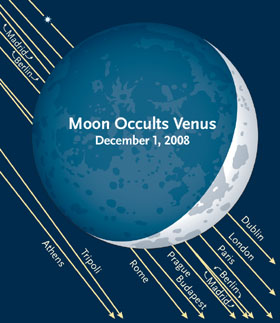|
The "Venus & Jupiter" Show
Alan MacRobert
And on the evening of December 1st, skywatchers in the Americas will see
the crescent Moon joining the two planets to make a remarkably compact
celestial triangle. It's sure to turn heads.
The illustration at right shows the scene.It's plotted for observers in the middle
of North America (and the alignment of the Venus-Jupiter pairing is exact for
December 1st), but it's close enough to give a good idea of how the scene will
look from anywhere in North America on the evenings in question.
Although the three objects appear close together, appearances in astronomy
are deceiving. The Moon is only 252,000 miles away, less far than you may
have driven in your lifetime. Right now Venus is 370 times farther away,
at 94 million miles. And Jupiter, at 540 million miles, is nearly six
times farther than Venus.
�If the sky is cloudy for this event, don't despair. Venus and the crescent
Moon will have another spectacular twilight pairing (though without Jupiter)
on December 31st, New Year's Eve.
This week's planet conjunction marks the second time this year that Venus
and Jupiter have mimicked a brilliant "double star" in our sky. Back on
February 1st, they appeared together in the eastern sky before dawn.
At that time they nestled even closer together — only ½° apart.
The last time these two planets were paired in the evening sky and easily
seen was September 2005, when they appeared about 1½° apart.
They won't be this close together and well placed for evening viewing again
until May 2013 (1° apart.)
Special Treat for Europeans
Across much of Europe, even people who never normally look up should watch
the western twilight on Monday evening, December 1st. The Moon will be right
next to Venus and Jupiter. But the real show happens when the Moon's dim,
earthlit edge occults (covers) dazzling Venus itself. The second act
happens roughly an hour or more later, when Venus reemerges into view from
behind the crescent's bright edge.
Venus will appear small and gibbous in a telescope, 69% sunlit and 17 arcseconds
across (a hundredth the diameter of the Moon). Because of Venus's significant
angular size, its disappearance and reappearance will each be gradual,
taking 30 seconds or more.
Source: "Sky & Telescope:
http://www.skyandtelescope.com/observing/home/35217944.html | |||
.jpg)
.jpg)
